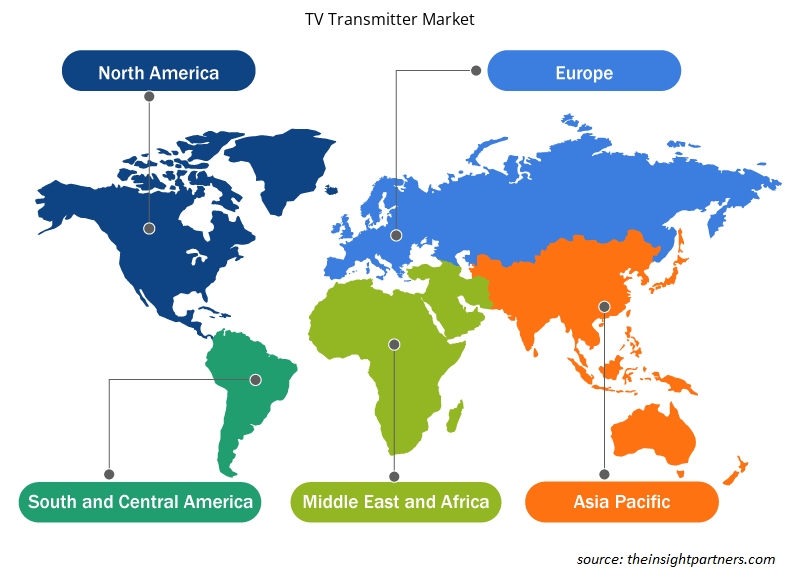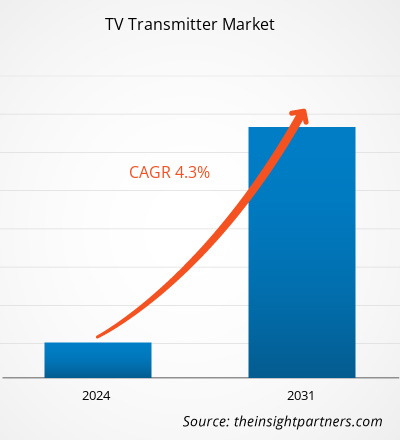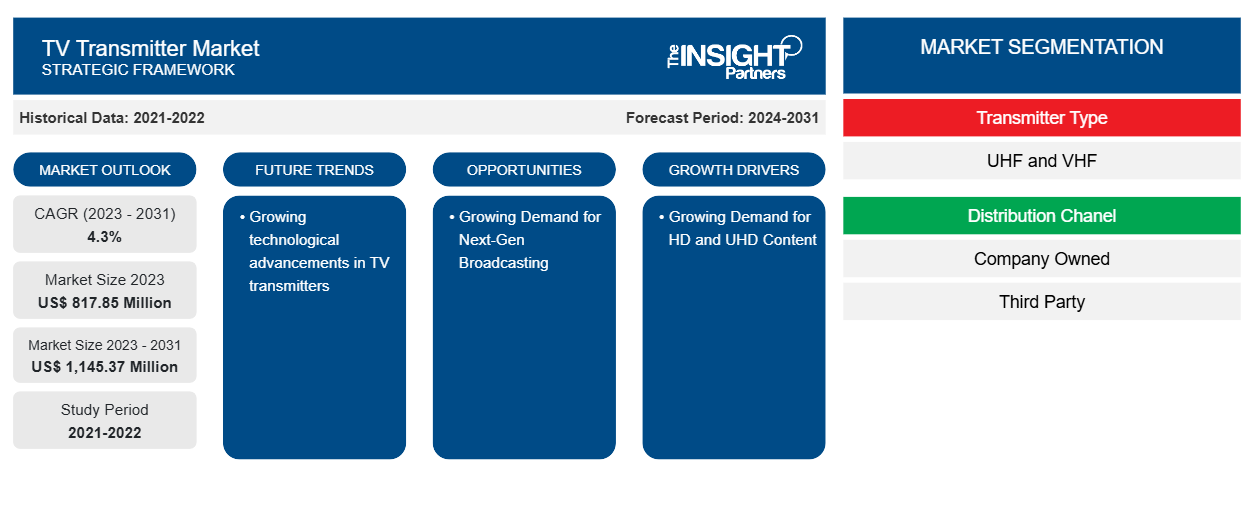Si prevede che la dimensione del mercato dei trasmettitori TV raggiungerà 1.145,37 milioni di $ USA entro il 2031 dagli 817,85 milioni di $ USA nel 2023. Si prevede che il mercato registrerà un CAGR del 4,3% nel 2023-2031. È probabile che la crescente domanda di contenuti ad alta definizione rimanga una tendenza chiave del mercato dei trasmettitori TV.
Analisi del mercato dei trasmettitori TV
La crescente domanda di contenuti HD e UHD in tutto il mondo è uno dei principali fattori che alimentano la crescita del mercato dei trasmettitori TV. Inoltre, le costanti innovazioni nel settore delle telecomunicazioni e della radiodiffusione stanno guidando la crescita del mercato dei trasmettitori TV. Inoltre, si prevede che la crescente domanda di trasmissioni di nuova generazione stimolerà la crescita del mercato nel periodo previsto . Inoltre, i crescenti progressi tecnologici nei trasmettitori TV stanno creando un'opportunità per la crescita del mercato dei trasmettitori TV nei prossimi anni.
Panoramica del mercato dei trasmettitori TV
Un trasmettitore TV è un dispositivo elettrico che emette onde radio che trasportano sia il segnale video che visualizza un'immagine dinamica sia il segnale audio che è sincronizzato con esso. Sarà ricevuto da un ricevitore televisivo, che visualizzerà l'immagine sullo schermo e riprodurrà il suono corrispondente. La sua frequenza operativa è limitata alle bande di frequenza VHF e UHF e la sua potenza di uscita varia da 5 W a 10 kW. È comunemente impiegato nel campo della trasmissione televisiva , come le stazioni TV.
Personalizza questo report in base alle tue esigenze
Riceverai la personalizzazione gratuita di qualsiasi report, comprese parti di questo report, o analisi a livello nazionale, pacchetto dati Excel, oltre a usufruire di grandi offerte e sconti per start-up e università
-
Scopri le principali tendenze di mercato in questo rapporto.Questo campione GRATUITO includerà analisi di dati che spaziano dalle tendenze di mercato alle stime e alle previsioni.
Driver e opportunità del mercato dei trasmettitori TV
Crescente domanda di contenuti HD e UHD
La domanda di contenuti ad alta definizione ( HD ) e ultra-alta definizione ( UHD ) sta aumentando tra i consumatori in tutto il mondo, in particolare perché forniscono audio e video di qualità superiore. Inoltre, l'uso di piattaforme OTT sta aumentando in tutto il mondo insieme alle uscite di contenuti di alta qualità. Pertanto, la crescente domanda di contenuti di alta qualità sta alimentando la crescita del mercato dei trasmettitori TV.
CrescenteDomanda di trasmissione di nuova generazione
La trasmissione di nuova generazione include l'adozione di standard di trasmissione digitale, con diverse regioni in tutto il mondo che adottano standard specifici come ATSC 3.0 negli Stati Uniti, DVB-T2 in Europa e ISDB-Tb in alcune sezioni dell'Asia e del Sud America. I vantaggi di questi standard includono una migliore qualità audio e video, un uso più efficace dello spettro disponibile e l'aggiunta di nuove funzionalità interattive. La transizione agli standard di trasmissione digitale semplifica la trasmissione di programmi ad alta definizione ( HD ) e ultra-alta definizione ( UHD ), che offrono agli spettatori un'esperienza visiva e audio molto migliore e aumentano il loro godimento della televisione. Pertanto, si prevede che la crescente domanda di trasmissione di nuova generazione creerà un'opportunità per la crescita del mercato dei trasmettitori TV.
Analisi della segmentazione del rapporto di mercato dei trasmettitori TV
I segmenti chiave che hanno contribuito alla derivazione dell'analisi di mercato dei trasmettitori TV sono il tipo di trasmettitore, il canale di distribuzione e l'applicazione.
- In base al tipo di trasmettitore, il mercato dei trasmettitori TV è diviso in UHF e VHF. Il segmento UHF ha detenuto una quota di mercato maggiore nel 2023. Il segmento UHF è ulteriormente suddiviso in basso, medio e alto. Analogamente, il segmento VHF è ulteriormente suddiviso in basso e medio.
- Per canale di distribuzione, il mercato è segmentato in di proprietà aziendale e di terze parti. Il segmento di proprietà aziendale deteneva la quota maggiore del mercato nel 2023.
- Per applicazione, il mercato è segmentato in piccole emittenti televisive e grandi emittenti televisive. Il segmento delle grandi emittenti televisive deteneva la quota maggiore del mercato nel 2023.
Analisi della quota di mercato dei trasmettitori TV per area geografica
L'ambito geografico del rapporto sul mercato dei trasmettitori TV è suddiviso principalmente in cinque regioni: Nord America, Asia Pacifico, Europa, Medio Oriente e Africa e Sud America/Sud e Centro America.
In termini di fatturato, l'Asia Pacifica ha rappresentato la quota di mercato più grande dei trasmettitori TV. Il mercato in questa regione è segmentato in Australia, Cina, India, Corea del Sud, Giappone e il resto dell'APAC. Gli operatori di mercato nella regione lavorano costantemente sui progressi tecnologici nel settore della trasmissione, che è il fattore principale che alimenta la crescita del mercato dei trasmettitori TV nell'APAC. Inoltre, la regione sta assistendo a una crescita enorme nel suo settore dei media e dell'intrattenimento, che sta ulteriormente alimentando la crescita del mercato dei trasmettitori TV.
Approfondimenti regionali sul mercato dei trasmettitori TV
Le tendenze regionali e i fattori che influenzano il mercato dei trasmettitori TV durante il periodo di previsione sono stati ampiamente spiegati dagli analisti di Insight Partners. Questa sezione discute anche i segmenti e la geografia del mercato dei trasmettitori TV in Nord America, Europa, Asia Pacifico, Medio Oriente e Africa e Sud e Centro America.

- Ottieni i dati specifici regionali per il mercato dei trasmettitori TV
Ambito del rapporto sul mercato dei trasmettitori TV
| Attributo del report | Dettagli |
|---|---|
| Dimensioni del mercato nel 2023 | 817,85 milioni di dollari USA |
| Dimensioni del mercato entro il 2031 | 1.145,37 milioni di dollari USA |
| CAGR globale (2023-2031) | 4,3% |
| Dati storici | 2021-2022 |
| Periodo di previsione | 2024-2031 |
| Segmenti coperti |
Per tipo di trasmettitore
|
| Regioni e Paesi coperti |
America del Nord
|
| Leader di mercato e profili aziendali chiave |
|
Densità dei player del mercato dei trasmettitori TV: comprendere il suo impatto sulle dinamiche aziendali
Il mercato dei trasmettitori TV sta crescendo rapidamente, spinto dalla crescente domanda degli utenti finali dovuta a fattori quali l'evoluzione delle preferenze dei consumatori, i progressi tecnologici e una maggiore consapevolezza dei vantaggi del prodotto. Con l'aumento della domanda, le aziende stanno ampliando le loro offerte, innovando per soddisfare le esigenze dei consumatori e capitalizzando sulle tendenze emergenti, il che alimenta ulteriormente la crescita del mercato.
La densità degli operatori di mercato si riferisce alla distribuzione di aziende o società che operano in un particolare mercato o settore. Indica quanti concorrenti (operatori di mercato) sono presenti in un dato spazio di mercato in relazione alle sue dimensioni o al valore di mercato totale.
Le principali aziende che operano nel mercato dei trasmettitori TV sono:
- Rohde e Schwarz
- Società NEC
- Gruppo elettrico Hitachi Kokusai
- BTESA
- Egatel
- Cancelli Aria
Disclaimer : le aziende elencate sopra non sono classificate secondo un ordine particolare.

- Ottieni una panoramica dei principali attori del mercato dei trasmettitori TV
Notizie e sviluppi recenti sul mercato dei trasmettitori TV
Il mercato dei trasmettitori TV viene valutato raccogliendo dati qualitativi e quantitativi dopo la ricerca primaria e secondaria, che include importanti pubblicazioni aziendali, dati associativi e database. Di seguito è riportato un elenco degli sviluppi nel mercato dei disturbi del linguaggio e della parola e delle strategie:
- ENENSYS Technologies, fornitore leader di soluzioni di distribuzione multimediale, ed ELECTROLINK, produttore italiano di trasmettitori TV, hanno annunciato di aver consegnato con successo a Rai Way tutti i sistemi di trasmissione DVB-T/T2 operativi nelle regioni di Abruzzo, Lazio e Liguria, relativi al progetto di riqualificazione in Italia, affidato tramite gara pubblica. ENENSYS ed ELECTROLINK hanno creato una partnership speciale per questo progetto, ciascuna azienda fornisce i migliori componenti e servizi di ingegneria per fornire a Rai Way il sistema di trasmissione DVB-T/T2 più efficiente, affidabile e all'avanguardia. (Fonte: ENENSYS Technologies, comunicato stampa, 2023)
- Hope Channel Central Philippines ha inaugurato il nuovo studio e sito di trasmissione presso la sede centrale della Central Philippine Union Conference (CPUC) a Cebu City, Filippine. (Fonte: Avventisti, comunicato stampa, 2023)
Copertura e risultati del rapporto sul mercato dei trasmettitori TV
Il rapporto "Dimensioni e previsioni del mercato dei trasmettitori TV (2021-2031)" fornisce un'analisi dettagliata del mercato che copre le seguenti aree:
- Dimensioni e previsioni del mercato a livello globale, regionale e nazionale per tutti i segmenti di mercato chiave coperti dall'ambito
- Dinamiche di mercato come fattori trainanti, vincoli e opportunità chiave
- Principali tendenze future
- Analisi dettagliata delle cinque forze PEST/Porter e SWOT
- Analisi di mercato globale e regionale che copre le principali tendenze di mercato, i principali attori, le normative e gli sviluppi recenti del mercato
- Analisi del panorama industriale e della concorrenza che copre la concentrazione del mercato, l'analisi della mappa di calore, i principali attori e gli sviluppi recenti
- Profili aziendali dettagliati
- Analisi storica (2 anni), anno base, previsione (7 anni) con CAGR
- Analisi PEST e SWOT
- Valore/volume delle dimensioni del mercato - Globale, Regionale, Nazionale
- Industria e panorama competitivo
- Set di dati Excel
Report recenti
Rapporti correlati
Testimonianze
Motivo dell'acquisto
- Processo decisionale informato
- Comprensione delle dinamiche di mercato
- Analisi competitiva
- Analisi dei clienti
- Previsioni di mercato
- Mitigazione del rischio
- Pianificazione strategica
- Giustificazione degli investimenti
- Identificazione dei mercati emergenti
- Miglioramento delle strategie di marketing
- Aumento dell'efficienza operativa
- Allineamento alle tendenze normative























 Ottieni un campione gratuito per - Mercato dei trasmettitori TV
Ottieni un campione gratuito per - Mercato dei trasmettitori TV